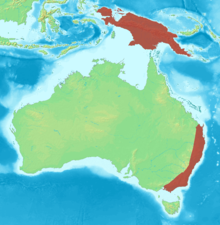Sooty owl
| Sooty owl | ||||||||||||
|---|---|---|---|---|---|---|---|---|---|---|---|---|

Black Owl ( Tyto tenebricosa ) |
||||||||||||
| Systematics | ||||||||||||
|
||||||||||||
| Scientific name | ||||||||||||
| Tyto tenebricosa | ||||||||||||
| ( Gould , 1845) |
The black owl ( Tyto tenebricosa ), also known as the black barn owl, is a species of barn owl that occurs in New Guinea and southeastern Australia. It is a very secretive species that usually only reveals its presence through its characteristic calls.
features
The black owl reaches a body size of 37 to 43 cm, has a wingspan of about 24 to 35 cm and a weight of 500 to 1160 g. The females are in most cases slightly larger than the males and up to 350 g heavier. For a barn owl, it has unusually large eyes for its size. Besides the difference in size, there is no gender dimorphism , i. H. Males and females are colored the same. The face veil is unlike many barn owls species not heart-shaped, but oval.
The neck, chest, back, the tops of the head, wings and tail are brownish to blackish and speckled with small white dots. The belly is patterned by an irregular, fine band. The face mask is gray-white, rather dark around the eyes and beak and lighter towards the edge. The iris is black-brown, the beak whitish to beige. The strong claws are black to dark brown. Like all barn owls, the black owl has no feather ears.
voice
The most heard call of the soot owl is a long drawn-out whistle, the pitch of which drops. It is also described with the sound of a falling bomb.
Possible confusion
In Australia, the range overlaps with the New Holland owl and the giant owl . Both species of owl are significantly larger than the sooty owl. The sooty owl is also found in much more closed forest regions than either of these two species. In the northern Australian range, the range also overlaps with the red owl . This is also significantly larger than the soot owl.
Distribution and subspecies
The black owl is divided into two subspecies, T. tenebricosa arfaki in New Guinea (including Yapen ) and the nominate form T. tenebricosa tenebricosa , which occurs in south-east Queensland , east New South Wales and Victoria . The sooty owls from New Guinea are smaller (500 and 750 g) and more brown in color. In northeast Queensland, between the distribution areas of the two subspecies, lies the area of the spotted soot owl ( Tyto multipunctata ), which was formerly also considered a subspecies of the soot owl.
Way of life
The sooty owl occurs in rainforests, in high eucalyptus forests and on the edges of forests from low altitudes to altitudes of over 3500 m . It finds its resting places in dense vegetation near the ground and in hollows. In human settlements, she also uses chimneys as resting places. She is sedentary and is defending a river. Mated black owls usually seek separate resting places, but keep in contact with each other by shouting. The size of the area in the Australian range is between 200 and 800 hectares.
The sooty owl feeds mainly on various tree-dwelling small mammals, including small marsupials and bats, and small birds and reptiles are also preyed on. Historically and prehistorically (before the settlers invaded from Europe) it lived more on terrestrial small mammals. She usually begins her hunt before dawn. She combs through the area of the treetops as well as forest edges and clearings.
Reproduction
Black owls are not tied to any specific breeding season. They then move to brood when there is a sufficient food base. In Australia, however, a breeding season between February and April is typical. Only one brood is raised per year.
Sooty owls usually breed in large tree hollows. They usually use suitable breeding sites for several years. The clutch usually consists of two eggs. The female breeds alone and later breeds the nestlings alone. The begging calls of the nestlings are long, rough calls. The male brings food to the nest during the nestling period. However, he hands this over to the female and only the female parent bird feeds the nestlings. The nestlings are fledged three months after the eggs are laid. They stay in the parent bird's territory for around four to five months and then have to look for their own territory. They are fertile at an age of one year.
Danger
The black owl is widespread in New Guinea and the population is not endangered, but the southeast Australian subspecies is rare.
literature
- Claus König , Friedhelm Weick: Owls of the World . Christopher Helm, London 2008, ISBN 978-0-7136-6548-2 .
- Heimo Mikkola: Handbook owls of the world. Franckh-Kosmos, 2013, ISBN 978-3440132753 , page 114.
- Ronald Strahan: Cuckoos, Nightbirds & Kingfishers of Australia . Angus & Robertson, Sydney 1994, ISBN 0-207-18522-0 .
Web links
- Tyto tenebricosa in the endangered Red List species the IUCN 2014 Posted by: BirdLife International, 2014. Accessed December 11, 2015.
- Call of the black owl on Xeno-Canto
Individual evidence
- ↑ Hans Hvass: Birds of the World , Gebrüder Weiß Verlag, Berlin-Schöneberg, p. 107/08
- ↑ a b c d Strahan: Cuckoos, Nightbirds & Kingfishers of Australia . P. 62.
- ^ Rohan J. Bilney, Raylene Cooke, John White: Change in the diet of sooty owls (Tyto tenebricosa) since European settlement: from terrestrial to arboreal prey and increased overlap with powerful owls. In: Wildlife Research , Vol. 33, No. 1, 2006, pp. 17-24.
- ^ A b Strahan: Cuckoos, Nightbirds & Kingfishers of Australia . P. 64.
- ^ Strahan: Cuckoos, Nightbirds & Kingfishers of Australia . P. 63.
